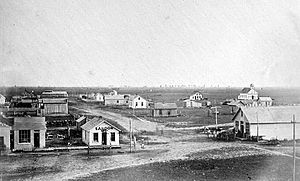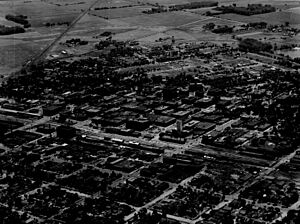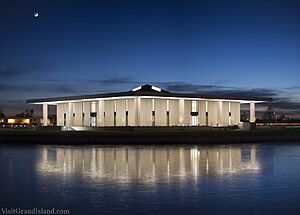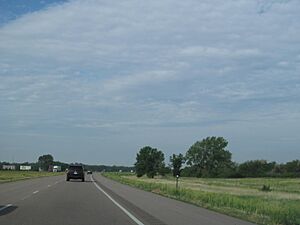Grand Island, Nebraska facts for kids
Quick facts for kids
Grand Island, Nebraska
|
|
|---|---|
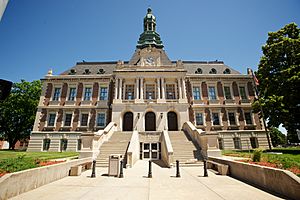
Hall County Courthouse in Grand Island,
June 2014 |
|
| Nickname(s):
La Grande Ile
|
|

|
|
| Country | United States |
| State | Nebraska |
| County | Hall |
| Area | |
| • Total | 30.28 sq mi (78.44 km2) |
| • Land | 30.09 sq mi (77.92 km2) |
| • Water | 0.20 sq mi (0.51 km2) |
| Elevation | 1,870 ft (570 m) |
| Population
(2020)
|
|
| • Total | 53,131 |
| • Rank | 4th in Nebraska |
| • Density | 1,765.97/sq mi (681.85/km2) |
| Demonym(s) | Grand Islander |
| Time zone | UTC−6 (CST) |
| • Summer (DST) | UTC−5 (CDT) |
| ZIP code |
68801-68803
|
| Area code | 308 |
| FIPS code | 31-19595 |
| GNIS feature ID | 838031 |
| Website | grand-island.com |
Grand Island is a city in Nebraska, United States. It is the main city in Hall County. In 2020, about 53,131 people lived there. This makes it the fourth largest city in Nebraska.
Grand Island is the biggest city in the Grand Island metropolitan area. This area includes Hall, Merrick, Howard, and Hamilton counties. About 83,472 people live in this larger area.
The city has won the All-America City Award four times. This award celebrates cities that work together to solve problems. Grand Island is also where police officers in Nebraska get their training. A company called Hornady, which makes ammunition, is also located here.
Contents
Grand Island's Story: A Look Back
How Grand Island Began (1800s)
In 1857, 35 German settlers left Davenport, Iowa. They traveled west to Nebraska to start a new town. They chose an island known as La Grande Isle by French traders. This island was formed by the Wood River and the Platte River.
The settlers arrived on July 4, 1857. By September, they had built homes using wood from the area. They started farms but had no place to sell their crops. Later, a market opened at Fort Kearny. When the Pike's Peak Gold Rush started, Grand Island became important. It was the last place travelers could get supplies before crossing the plains.
Surveyors from the Union Pacific Railroad (UP) planned a new town. They called it Grand Island Station. Many settlers moved from the island to this new town. In 1868, the railroad reached the area. This brought more trade and business.
Grand Island became the end of the railroad's eastern section. The UP built facilities for their trains there. They also built a fancy hotel for passengers. This helped the local economy grow a lot. To build the railroad, most of the island's hardwood trees were cut down. By 1870, 1,057 people lived in the town. In 1872, Grand Island officially became a city.
Around 1890, sugar beets became a new crop in Nebraska. The first sugar beet processing factory in the United States was built in Grand Island. By 1900, it was the third largest city in the state.
Growing Through the 1900s
Throughout the 20th century, Grand Island kept growing. Its location along the railroad was very helpful. The city remained Nebraska's third largest city for many years. However, in 2000, Bellevue grew larger.
Grand Island Today (2000s)
Grand Island has worked to improve itself in the 21st century. The city's airport has been expanded several times. Also, the Nebraska State Fair moved to Grand Island.
The 1980 Tornadoes
On June 3, 1980, a huge storm hit Grand Island. Seven tornadoes struck the city that evening. The strongest tornado was rated F4 on the Fujita Scale. The South Locust business area was hit the hardest. Five people died because of the tornadoes.
Tornado Hill is a local landmark. It was created from the storm's cleanup. Debris that could not be recycled was burned. The rest was buried in Ryder Park. The hill is 40 feet high. It is used for sledding in this flat area.
A book, Night of the Twisters, was written about this event. A movie was also made based on the book.
Grand Island's Location and Weather
Where Grand Island Is Located
The city covers about 28.55 square miles (73.9 km2). Most of this area is land. Grand Island is just a few miles north of the Platte River. This is one of Nebraska's most important rivers. Many major cities in the state are located along it.
Grand Island's Climate
Grand Island has a climate with warm summers and cold winters. It gets both rain and snow throughout the year. The hottest month is usually July. The coldest month is January.
People of Grand Island
| Historical population | |||
|---|---|---|---|
| Census | Pop. | %± | |
| 1870 | 1,057 | — | |
| 1880 | 2,963 | 180.3% | |
| 1890 | 7,536 | 154.3% | |
| 1900 | 7,554 | 0.2% | |
| 1910 | 10,326 | 36.7% | |
| 1920 | 13,947 | 35.1% | |
| 1930 | 18,041 | 29.4% | |
| 1940 | 19,130 | 6.0% | |
| 1950 | 22,682 | 18.6% | |
| 1960 | 25,742 | 13.5% | |
| 1970 | 32,358 | 25.7% | |
| 1980 | 33,180 | 2.5% | |
| 1990 | 39,386 | 18.7% | |
| 2000 | 42,940 | 9.0% | |
| 2010 | 48,520 | 13.0% | |
| 2020 | 53,131 | 9.5% | |
| U.S. Decennial Census | |||
Population in 2020
The 2020 United States census counted 53,131 people in Grand Island. There were 19,601 households and 12,983 families. About 65.8% of the people were white. About 32.0% of the population was Hispanic or Latino.
About 27.2% of the people were under 18 years old. The average age in the city was 35.0 years. The average household had 2.6 people. The average family had 3.1 people.
The average income for a household was about $56,513. About 11.8% of the population lived below the poverty line. This included 16.6% of those under 18.
Fun Things to Do in Grand Island
Nebraska State Fair
Since 2010, Grand Island has been home to the Nebraska State Fair. Thousands of people visit the city for the fair each year. In 2024, over 300,000 people attended the fair.
Stuhr Museum
The Stuhr Museum is in Grand Island. It is also called the Museum of the Pioneer Prairie. The museum has over 140,000 items from early settlers in central Nebraska.
It features a "living history" village called Railroad Town. This village looks like a prairie town from the 1890s. Many original buildings were moved to the museum to create it.
Parks and Outdoor Fun
Grand Island has several parks. Some of the most well-known are Stolley Park and the George Clayton Hall County Park. These parks offer places for people to relax and play outdoors.
Getting Around Grand Island
Main Roads
Interstate 80 is a major highway. It is located four miles south of the city. U.S. Route 281 runs north-south through the city's west side. U.S. Route 30 goes east-west through the center of Grand Island.
Airport and Buses
The Central Nebraska Regional Airport is in Grand Island. You can fly from here to places like Las Vegas, Nevada. You can also fly to Dallas/Fort Worth, Texas.
Buses like Burlington Trailways and Express Arrow also serve Grand Island. The city's local bus system requires you to book rides 24 hours in advance.
Grand Island has fifteen traffic circles, also known as roundabouts. These help traffic flow smoothly.
Hospitals
Grand Island has two hospitals. They are CHI Health St. Francis Hospital and Grand Island Regional Medical Center. Grand Island Regional Medical Center opened in 2020.
Media and Education
Radio Stations
Grand Island has several radio stations. These include:
- KRGI (AM) 1430
- LA GRAN D 93.3
- KRGI-FM 96.5
- KRGY FM 97.3
- KKJK FM 103.1
- KSYZ-FM 107.7
- KMTY-FM97.7/99.7
Schools and Colleges
Grand Island has its own school districts. These include Grand Island Public Schools and Grand Island Northwest Public Schools.
There are also several high schools:
- Central Catholic High School
- Grand Island Senior High School
- Heartland Lutheran High School
- Northwest High School
For higher education, students can attend:
- Central Community College
- University of Nebraska at Kearney
Famous People From Grand Island
Many notable people have connections to Grand Island:
- Edith Abbott, a social worker
- Grace Abbott, who helped create the Social Security Act
- Rick Allen, a NASCAR commentator
- Bil Baird, a famous puppeteer
- Dick Cavett, a well-known talk show host
- Henry Fonda, an Academy Award-winning actor
- John Parrella, a former NFL player
- Tom Rathman, another former NFL player
See also
 In Spanish: Grand Island (Nebraska) para niños
In Spanish: Grand Island (Nebraska) para niños


